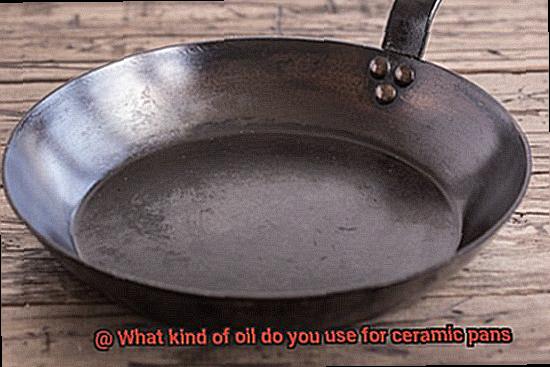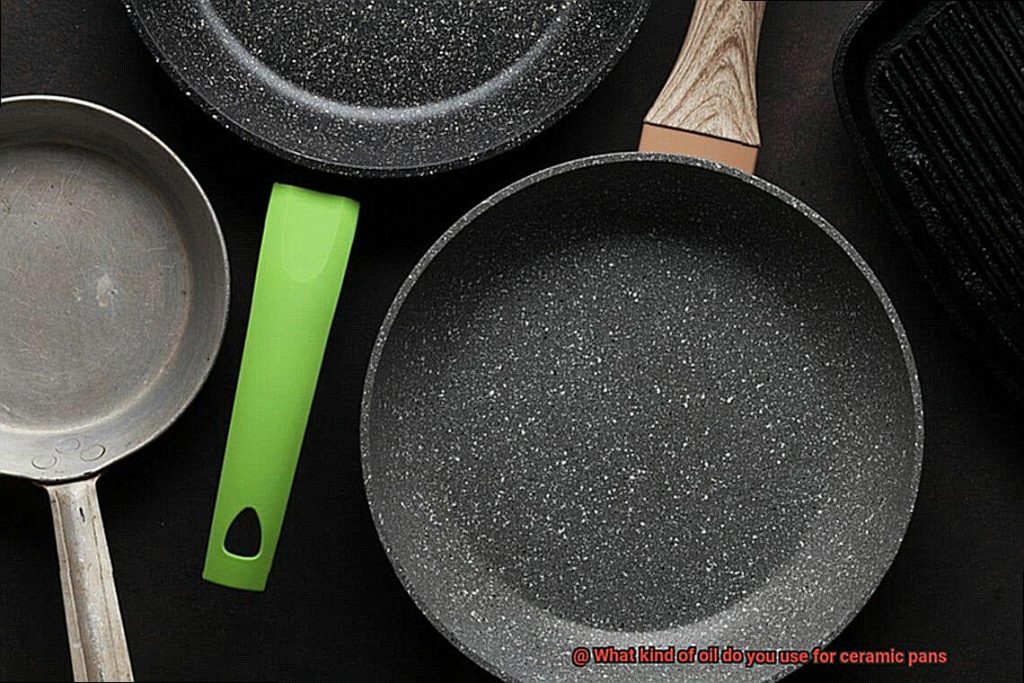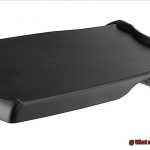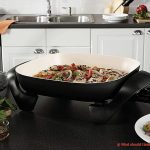Do you find yourself struggling to cook a meal without having to scrape off the remnants of your last one from your ceramic pans? Fear not, my friend. The key to non-stick ceramic pans is in the type of oil you use.
But what kind of oil should you use for ceramic pans, you ask? It’s simple – high smoke point oils.
High smoke point oils are those that can endure high temperatures without burning or smoking. This makes them perfect for cooking on ceramic pans. Some of the best options include avocado oil, grapeseed oil, and coconut oil.
But why is the smoke point so crucial? Well, when oils are heated past their smoke point, they start to break down and release harmful compounds. This leads to a burnt taste and possible health risks.
By using the right type of oil on your ceramic pans, not only will you prevent sticking and achieve a beautiful sear, but you’ll also be maintaining the quality of your pans while keeping your food healthy and delicious.
So next time you’re cooking with ceramic pans, grab a high smoke point oil and watch as your meals come out perfectly every single time.
Contents
What is Ceramic Cookware?
Ceramic cookware has revolutionized the cooking world as a safe and healthy alternative to traditional non-stick pans. But what exactly is ceramic cookware, and why has it gained such popularity?
The process of making ceramic cookware involves coating a metal base with a layer of ceramic material, which is then fired at high temperatures to create a smooth and durable cooking surface. This special coating provides a non-stick surface that is free from harmful chemicals commonly used in traditional non-stick pans.
One of the main benefits of ceramic cookware is its even heat distribution and retention, which allows for consistent cooking results. This feature ensures that your food is cooked evenly, without hot spots that can lead to over or undercooked meals. Additionally, ceramic cookware is easy to clean and maintain, as it is dishwasher safe and does not require any special seasoning.
However, not all oils are suitable for use with ceramic cookware. It’s important to choose the right oil for your specific cooking needs to ensure that your pans remain in good condition and your food is cooked to perfection without any unwanted burnt or sticky residue.
Some great options for cooking with ceramic pans include oils with high smoke points such as avocado oil, grapeseed oil, and refined coconut oil. These oils can withstand high temperatures without burning or leaving a residue on the pan.
On the other hand, oils with low smoke points such as olive oil, butter, and margarine should be avoided when using ceramic cookware. These oils can produce smoke and leave a residue on the pan, causing damage to the non-stick coating.
It is worth noting that even when using an oil with a high smoke point, it’s still essential to monitor the heat of the pan and not exceed the recommended temperature range for the specific oil.
Benefits of Using Ceramic Cookware
If so, it’s time to switch to ceramic cookware, a versatile and durable option that will revolutionize your cooking experience. As an expert in this field, I can attest to the numerous benefits of using ceramic cookware.

The most significant advantage of ceramic cookware is its non-stick surface. Unlike conventional pans, which require a lot of oil or butter to prevent sticking, ceramic pans require minimal oil. This makes them an ideal choice for health-conscious individuals looking to reduce their calorie intake and make healthier meals. Plus, the non-stick surface ensures that you won’t have to worry about scraping off burnt or stuck-on food.
Another benefit of ceramic cookware is its versatility. You can use it on any heat source, including gas, electric, and induction stovetops. Moreover, it’s oven safe, so you can seamlessly transfer dishes from stovetop to oven without worrying about switching pans. This versatility makes it an excellent option for dishes that require both stovetop and oven cooking.
Ceramic cookware is also known for its even heat distribution, ensuring that food cooks evenly throughout the pan and reducing the likelihood of hot spots or burnt areas. Additionally, ceramic cookware is generally easy to clean and is dishwasher safe. Just rinse with soap and water or pop it in the dishwasher for hassle-free cleaning.
Finally, ceramic cookware is a durable option that can withstand high temperatures without warping or cracking. With proper care and maintenance, it can last for years, making it a smart investment for your kitchen.
What is the Best Oil for Ceramic Pans?
Then you must know that choosing the right oil is as important as selecting the right ingredients for your dish. Using the wrong oil can not only ruin your food but also damage your pan. So, what is the best oil for ceramic pans? Let’s dive into some research and find out.
Avocado oil is undoubtedly one of the best oils for ceramic pans. With its high smoke point of 520°F, it’s perfect for high-heat cooking methods like stir-frying and searing. The neutral flavor of avocado oil won’t overpower your dish’s taste, and it’s loaded with healthy monounsaturated fats that can improve heart health and reduce inflammation.
Another great option is coconut oil, with a slightly sweet and nutty flavor that can add depth to any dish. Although its smoke point is lower than avocado oil at around 350°F, it’s still suitable for most cooking methods. Moreover, coconut oil contains lauric acid, which has antibacterial and antiviral properties.
If you’re on a budget, a high-quality vegetable oil can be an excellent choice for ceramic pans. But make sure to select a pure vegetable oil with a smoke point of at least 400°F. Always check the label to ensure that there are no additives present.
However, using oils like olive oil and butter with ceramic pans are not recommended as they have low smoke points and can easily burn. This can ruin the taste of your food and damage your pan.
High Smoke Point Oils for Ceramic Pans
First up, we have the powerhouse of high heat oils – avocado oil. With a smoke point of around 520°F, this oil is perfect for searing meats and stir-frying veggies. Bonus points for its rich concentration of healthy fats and antioxidants, making it an excellent choice for the health-conscious chef.
Next, we have grapeseed oil, which boasts a smoke point of around 420°F. This oil is not only excellent for high-heat cooking but also contains high levels of vitamin E and antioxidants that can help boost your overall health.
If you’re looking for a neutral-tasting oil, refined peanut oil with a smoke point of around 450°F is a great option. It’s perfect for frying up your favorite foods without adding any unwanted flavors.
Refined coconut oil and refined sunflower oil are both excellent choices too, with a smoke point of around 450°F. And let’s not forget about canola oil, which has a smoke point of around 400°F.
Low Smoke Point Oils to Avoid with Ceramic Pans
So, you’ve invested in a brand new ceramic pan and are ready to whip up some culinary masterpieces. But before you start cooking, it’s crucial to know which oils to avoid. Low smoke point oils are a big no-no when it comes to ceramic pans. These oils are prone to burning quickly, releasing a pungent smoke that can ruin the flavor of your food and even damage your pan. Common examples of low smoke point oils include flaxseed oil, hemp oil, and walnut oil.
But that’s not all. Even though extra virgin olive oil has a high smoke point, it’s not the best option for ceramic pans. The oil can leave a residue on the surface of the pan that’s difficult to clean off. Over time, this can lead to discoloration and decreased non-stick properties.
So, what should you use instead? Opt for oils with high smoke points like avocado oil, grapeseed oil, or refined coconut oil. These oils can withstand high temperatures without breaking down or adding unwanted flavors to your food.
It’s essential to note that the quality and processing of an oil can significantly impact its smoke point. Always check the label or research before using any oil with your ceramic pans to make sure it has a high enough smoke point for your cooking needs.
Other Factors to Consider when Choosing an Oil for Ceramic Pans
It is a great addition to your kitchen, and it will help you cook up delicious meals. But before you start cooking, it is essential to choose the right oil for your pan. Smoke point and flavor are crucial, but there are other factors to consider that can impact your cooking and the longevity of your pan.
Firstly, think about the type of cooking you will be doing. If you are planning on using high-heat cooking methods such as searing or stir-frying, then oils with a high smoke point like avocado, grapeseed, or peanut oil are excellent options. These oils can handle high temperatures without smoking or breaking down. However, if you are using your pan for lower heat cooking methods like sautéing or baking, then oils with a lower smoke point like olive oil or coconut oil can work well too.
Secondly, consider the health benefits of different oils. While some oils may have a higher smoke point, they may not be the healthiest option. For example, vegetable and canola oils are commonly used for high-heat cooking due to their high smoke point but may contain harmful chemicals. Opting for healthier options like olive oil or coconut oil can provide healthy fats and antioxidants.
Thirdly, think about the impact on the longevity of your ceramic pan. Certain oils may cause a buildup of residue on your pan over time, leading to a decrease in its non-stick properties. Oils with high levels of saturated fats such as butter or lard may leave behind a sticky residue. Instead, opt for oils with low levels of saturated fats such as vegetable or canola oil which are less likely to build up residue on your pan. Additionally, avoid using non-stick sprays as they can leave behind a film that is difficult to remove.
Tips on How to Use an Oil with a High Smoke Point in a Ceramic Pan
Ceramic pans are great for cooking food evenly, but when it comes to using oil, it’s important to choose an oil with a high smoke point. Here are five tips on how to use an oil with a high smoke point in a ceramic pan:
Choose the Right Oil:
When it comes to using oil in a ceramic pan, it’s crucial to choose an oil with a high smoke point. Oils such as avocado oil, grapeseed oil, and refined coconut oil have high smoke points and can handle high-heat cooking without producing harmful fumes.
Use Oil Sparingly:
Using too much oil in a ceramic pan can lead to excess splattering and smoking, which can affect the quality and taste of your food. Instead, use a thin layer of oil to prevent sticking and ensure even cooking.
Preheat the Pan:
Before adding the oil, preheat the pan to help the oil spread evenly across the surface of the pan, preventing food from sticking. Once the pan is heated, add a small amount of oil and swirl it around to coat the surface evenly.
Avoid Overheating:
Overheating a ceramic pan can cause the oil to smoke and burn, which can ruin the flavor of your food. To prevent this from happening, keep an eye on the temperature of your pan and adjust the heat as necessary.
Monitor Your Cooking:
Even when using an oil with a high smoke point, it’s important to monitor your cooking carefully. Don’t exceed the recommended temperature range for your specific oil and keep an eye on your food to ensure it’s cooking evenly.
Rn_txCvfSx0″ >
Conclusion
In summary, the key to cooking with ceramic pans is using the right oil. Achieving non-stick perfection requires oils with high smoke points, such as avocado, grapeseed, and coconut oil. These oils not only prevent sticking and achieve a beautiful sear but also maintain the quality of your pans while keeping your food healthy and delicious.
Ceramic cookware has become a popular choice due to its many benefits, including even heat distribution and retention, versatility, ease of cleaning and maintenance, and durability. When selecting an oil for your ceramic pan, it’s crucial to consider factors like the type of cooking you’ll be doing and the health benefits of different oils.
To use high smoke point oils effectively in your ceramic pans, follow these tips: choose the right oil for your needs, use it sparingly, preheat the pan before adding oil, avoid overheating, and monitor your cooking carefully. With these techniques in mind, you can cook up mouth-watering meals without any sticky or burnt residue left behind.
In conclusion, don’t underestimate the importance of choosing the right oil for your ceramic pans.






